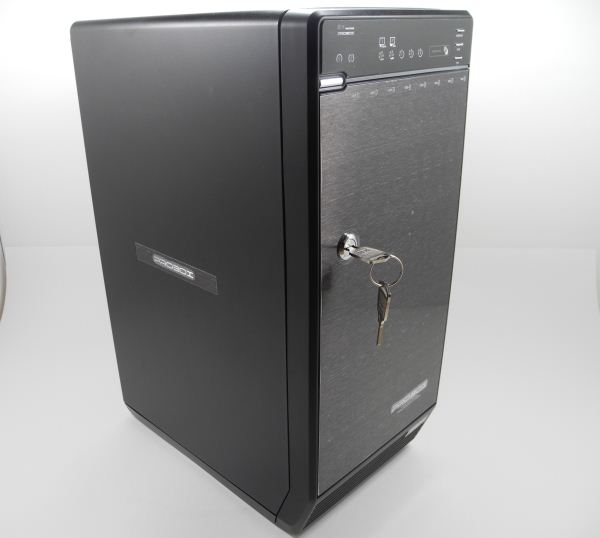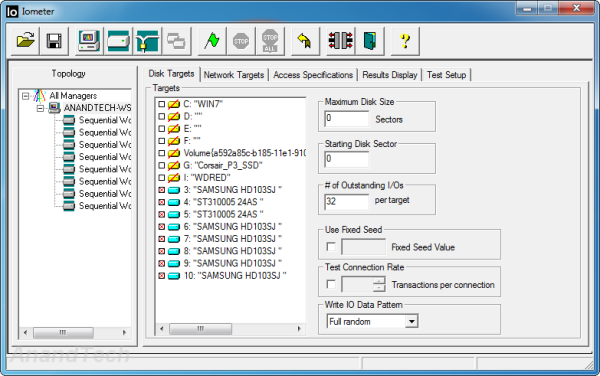Mediasonic Probox 8-bay 3.5" USB 3.0 / eSATA DAS Review
by Ganesh T S on August 4, 2012 7:55 AM ESTIntroduction
Prior to the rapid rise in popularity of Network Attached Storage (NAS) devices, consumers used to store large amounts of data on Direct Attached Storage (DAS) units. While USB 2.0 and Firewire used to be the interface of choice earlier, neither of them could maximize the bandwidth capabilities of the storage units (HDDs). USB 3.0 and eSATA serve the current day consumers in a more efficient way. We believe that the adoption of Thunderbolt in computing systems will make DAS units more relevant as the days go by. Today, we will take a look at the Mediasonic H82-SU3S2 3.5" USB 3.0 / eSATA Probox 8-bay external hard drive enclosure.
Mediasonic's H82-SU3S2 is a branded version of ODM manufacturer Hotway's H82-SU3S2, and utilizes a bunch of JMicron bridge chips. The unit is capable of being connected to the PC through either USB 3.0 or eSATA. The latter case needs a port multiplier aware SATA host controller on the PC side if more than one drive bay is being used. The operation is in single mode (JBOD) only, making the unit quite straightforward to use for the consumer.
Testbed Setup
Despite having a variety of systems with eSATA ports at my disposal, I was unpleasantly surprised to discovered that almost none of them had port multiplier capability inbuilt. These included boards based on the H55 and H65-M Intel chipsets as well as the AMD A50-M Hudson-M1. The A75 chipset in the ASRock A75 Pro4 supposedly has port multiplier capability. Unfortunately, ASRock confirmed that the current BIOS for that motherboard was not capable of supporting port multiplication.
In the process of sifting through the rest of the systems at my disposal, I found that the eSATA port on the Asus P8H77-M Pro that I had used for testing the HTPC credentials of Ivy Bridge was not from the H77 chipset, but, from a Marvell 88SE9172 SATA host controller. Though Asus doesn't specifically claim port multiplier support in the board, the data sheet for the Marvell controller indicated that it was compliant. In my initial testing, the port multiplier feature didn't work, but reinstalling the Marvell Magni driver after setting the eSATA port to be in AHCI mode resolved that issue (to some extent). There were no such issues with USB 3.0
| Mediasonic Probox 8-bay eSATA / USB 3.0 DAS Testbed Setup | |
| Processor | Intel Core i7-3770K - 3.50 GHz (Turbo to 3.9 GHz) |
| Intel HD Graphics 4000 - 650 MHz (Max. Dynamic Frequency of 1150 MHz) | |
| Motherboard | Asus P8H77-M Pro uATX |
| OS Drive | Seagate Barracuda XT 2 TB |
| Secondary Drives | Kingston SSDNow V+ 128 GB SATA II SSD SNV325-S2/128GB |
| Corsair Performance 3 Series SATA III SSD CSSD-P3128GB2 | |
| Memory | G.SKILL ECO Series 4GB (2 x 2GB) SDRAM DDR3 1333 (PC3 10666) F3-10666CL7D-4GBECO CAS 9-9-9-24 |
| Case | Antec VERIS Fusion Remote Max |
| Power Supply | Antec TruePower New TP-550 550W |
| Operating System | Windows 7 Ultimate x64 SP1 |
| Display | Acer H243H |
| . | |
From the perspective of the Probox enclosure, two sets of SATA drives were used. OCZ provided us with some Vertex 4 64GB units for our NAS testbed (about which I will be writing soon), and I took the opportunity to sneak in eight of them for evaluating the Probox before embarking on that build.
For meansurement of power consumption and performance under normal usage scenarios, a few mix-and-matched 7200rpm 1 TB hard drives (from Samsung and Seagate) were used.
In the next section, we will briefly go over the internals of the Probox and the build quality.













48 Comments
View All Comments
repoman27 - Saturday, August 4, 2012 - link
When you guys review USB 3.0 gear, you really need to address whose drivers you are using on the testbed and whether the device is operating in BOT, BOT with oversized payloads, or UASP mode.USB without UASP doesn't support queuing, so increasing the queue depths won't make much difference in your results. I'm guessing you were operating in BOT mode with default payload size and that is why eSATA was able to outperform USB 3.0. (And looking at the specs for the JMS539, I don't see any mention of UASP support.)
repoman27 - Saturday, August 4, 2012 - link
Also, most reviews don't mention specifically which USB 3.0 controller is being used, although in this case the board in question only has the integrated Intel controller.In the interview with JJ from Asus, he mentioned that memory bandwidth had an impact on Intel integrated USB 3.0 performance. I'm not sure if you have ever seen this borne out in actual testing, but I did note that your testbed was only running DDR3 1333.
ganeshts - Saturday, August 4, 2012 - link
I should have specified this in this review too. But, over here [ http://www.anandtech.com/show/6014/startechcom-usb... ], using the same testbed, we found that UASP is not supported by the Intel PCH's USB3 ports. Only ASMedia supports it right now.Further, the JMicron USB3 - SATA bridge supports only BOT specifications, as you have indicated. So, UASP enabled testbeds would probably have not made any difference.
repoman27 - Monday, August 6, 2012 - link
Supposedly some Asus boards will support UASP on the USB 3.0 ports provided by the Intel PCH using the Asus drivers. [ http://www.tomshardware.com/reviews/usb-3-uas-turb... ] I believe UASP is also supported for the integrated Intel USB 3.0 controller under Windows 8 and Mac OS X.Even using BOT though, increasing the maximum transfer length can have a considerable impact on sequential performance. So I wonder if your numbers are at the upper end for the Probox, or if it still had another 20-25% to go under USB 3.0 given the right conditions.
At this juncture, directly comparing benchmarks of USB 3.0 storage solutions is a total crap-shoot because there are so many variables and almost every site reviewing gear glosses over a fair number of the details.
yyrkoon - Saturday, August 4, 2012 - link
Ok I have not finished reading the article yet, but I *have* to say something.What do you mean there were no such issues with USB 3.0 in relation to your eSATA port multiplication issues ? This makes you the reviewer sound clueless. PM support always depended on very few specific Intel, Jmicron, and now I suppose Marvell chip sets to work..
Just to clarify This is a failing in your motherboard(s) or discrete eSATA controller cards. Not the fault of the enclosure. .
yyrkoon - Saturday, August 4, 2012 - link
Sorry, I said Intel Chip sets, where I meant Silicon image chip sets. Silicon image 3114, and 3132 chip sets where provided on a very few motherboards back in the Core2Duo days. A few generations of motherboards before ABIT dropped out of the motherboard business.At any rate. Addonics has made/sold PM capable controller cards for years.
ganeshts - Saturday, August 4, 2012 - link
When I specificed 'USB 3.0 had no such issues', I meant that I was able to access all the drives in the enclosure without experiencing BSODs unlike the eSATA case. I think all our readers know enough to understand that USB 3.0 has no port multiplication feature :)Yes, I have mentioned that it is a problem of the eSATA ports of most systems out there, and I have also mentioned that Mediasonic should have bundled one of those eSATA cards capable of seeing 8 drives through the eSATA port. Otherwise, they end up with customer service threads like the one here : http://forum.mediasonic.ca/viewtopic.php?f=27&...
yyrkoon - Saturday, August 4, 2012 - link
"I think all our readers know enough to understand that USB 3.0 has no port multiplication feature :)"This is not what I was saying. My point was that technically, the eSATA issues you had, was all the fault of the hardware you used to connect to the tower. E.G. your motherboards. But it looked like you were saying that Mediasonic's eSATA implementation was bad. Which is very likely not the case. No use in lamenting over a controller card not being included. As when you purchase such a device. You had better know what you're getting into, and you should already know this.
This is the problem with multiple drive eSATA technology. It is complicated, convoluted, and in general half baked from conception compared to other technologies. However, do not get me wrong, I personally was very interested in eSATA PM technology from the start 5+ years ago. From specification to end user product however. It rarely pans out very well. Unless you spend boatloads of cash. Where you have to ask yourself "why eSATA instead of SAS, or ( insert other external drive technology here )..
With everything above said. I think that manufactures should just leave eSATA out of the mix, and pass the savings onto us. the consumers. USB3 is not great, but it is good enough and flexible. Thunderbolt I think could be a great option too. If someone were to make say a 4 SATA drive to Thunderbolt bridge device.
As for the "bad customer service thread thing". I think you would find that with many, many eSATA implementations. Even the single drives ones. Have many issues. Where drives suddenly drop offline, experience terrible speeds. ETC,ETC. This is why yours truly completely opted out of eSATA entirely, and went with USB3.
tuxRoller - Sunday, August 5, 2012 - link
I interpreted the author as saying that the problem lay in the side of the motherboard companies making it too difficult to determine if their esata chip is multi-port aware.yyrkoon - Sunday, August 5, 2012 - link
Yeah I got that. However, I like you recognized the authors um . . . obvious inexperience with the given technology.You *do not* go out and test equipment like this without having the proper support hardware as well. Complaining, whining, or otherwise crying about hardware not included is simply inexcusable.
The things you, and I both know. Is that port multiplier technology does not work without the proper controller chip set period. Sometimes, with the right equipment, you *can* perhaps access RAID arrays previously setup by a system that did have the right controller chip set. However, that array has to have previously been setup with an appropriate SI controller( or equivalent ). It is miraculous that the reviewer was even able to see even a single drive. Let alone all drives one at a time. If I understood what was written correctly. Granted, a few Addonics products can / do this for the user through hardware switches. . .
You know this. I know this. The difference between you and I however. Is that you have actual hands on experience with the hardware / technology. I on the other hand have no hands on experience. Just a lot of reading over the past several years ( since the specification was released ). As eSATA PM technology has always been of interest to me.
The point being here. Is that if someone can have knowledge of something without laying hands on actual hardware. There is no reason why a reviewer ( hopefully someone with some expertise ) should not as well.
@ Ganesh
Take this as a learning experience Ganesh. Not a slight. With a little more preparation, research, then perhaps willingness to work with the given hardware. Us readers could have learned more, and we could have had a proper review of the given product. As it stand, personally I feel like your review is incomplete.